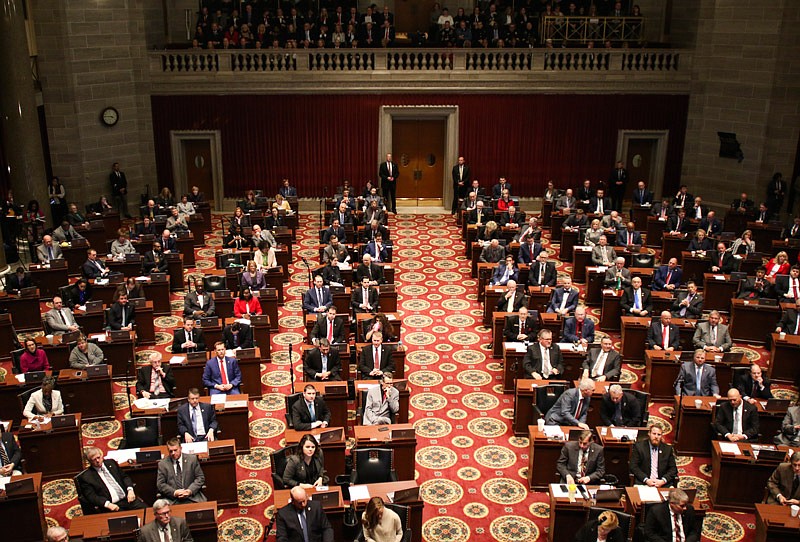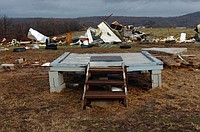Infrastructure funding was a common refrain in Gov. Mike Parson's State of the State speech Wednesday afternoon, as he praised lawmakers for approving new funding for roads and bridges last year - and promised more big projects.
Last year, the General Assembly approved $400 million for road and bridge improvements, including $50 million to match localities on their projects and a $300 million bonding program that took effect when the state received an $81.2 million federal grant toward replacing the Interstate 70 bridge at Rocheport.
Pat McKenna, Missouri Department of Transportation director, said it was the first new revenue source for transportation the Legislature has approved in 15 years. It fits into a $586.2 million plan to fund repairs for 251 bridges. Only 26 of the bridges are in St. Louis or Kansas City.
The state issued $201 million of that debt in November at the "unbelievably low interest rate" of 1.24 percent, which will leave the state paying less than $15 million in interest, when they initially expected the bonds to leave them owing $100 million in interest, McKenna said.
"We're going to have bridges completed this spring, less than a year into that program," he said.
Story continues below photo gallery
Parson singled out grants the state secured for projects including completing the MacArthur Bridge in St. Louis, improving the river port in Cape Girardeau, the East Locust reservoir project in northern Missouri and wrapping up the I-49 Bella Vista Bypass in Southwest Missouri. He also promised to build the Buck O'Neil Bridge over the Missouri River in Kansas City, drawing enthusiastic applause from Kansas City-area lawmakers.
Parson also touted the $50 million cost-share program the Legislature approved last year, which he said will contribute to nearly $150 million in new infrastructure investment and an economic impact of nearly $350 million.
MoDOT selected 20 projects to receive matching funds out of that program, including $1.91 million toward three roundabouts in the Clark Avenue corridor in Jefferson City. He said he wants the Legislature to put another $50 million toward the cost-share program this year.
The state's investment in smaller bridge projects also freed up revenue for larger projects, such as the $278 million project to add lanes, rebuild interchanges and make other improvements to Interstate 270 in St. Louis County, Parson said.
Parson made developing Missouri's economy and workforce another focus of his speech, touting a $33.5 million preschool development grant for preschool development and asking for $750,000 to get 12,000 high school students work-ready certification through the Work Ready program. He also said he wanted to ask school boards, school districts and DESE to propose a plan to raise teacher pay.
"Our children are the true workforce of tomorrow," he said.
He praised businesses bringing new jobs into Missouri, including a $110 million Dollar Tree distribution center in Warrensburg that's expected to create 375 new jobs, and the $250 million Nucor Steel plant that's close to opening in Sedalia, creating 250 jobs. Parson said infrastructure is key to workforce and economic development.
"We can't emphasize workforce development without infrastructure," Parson said. "That is a big reason why approximately $5 billion in new private investment has poured into our state, why our unemployment remains at record lows, why we are pulling ahead of our neighboring states, and we must keep up the hard work."
Despite taking on the repair or replacement of 251 bridges, the state still has a lot of bridges to fix. In Missouri, 909 of the state's 10,384 bridges are considered to be in poor condition. That's down from 922 in 2017, but the number of bridges in poor condition had been rising steadily each year from 852 bridges in 2014.
The number of bridges considered in good condition continued to decline, with 3,243 considered in good condition in 2018, compared to 3,727. The state's report compares Missouri's bridges to Ohio, where 223 of the state's 10,427 were considered in poor condition.
If legislators want to, they could issue more bonds in the future to take on another chunk of projects, but the state still needs another solution to have the infrastructure the public wants, McKenna said.
"We can only build a bridge when we have money to build a bridge," he said.
The state's 2018 long-term transportation plan projects it will spend $1.37 billion a year on roads and bridges, with 90 percent going toward construction and maintenance. MODOT expects that will leave $825 million a year in unfunded transportation needs, largely in major interstate reconstruction and economic growth and safety projects. It would also leave $95 million in bridge improvement and $50 million in road improvement projects unfunded each year.
Only about $11 million of the $2.18 billion the state spends on transportation comes from its general revenue. Almost two-thirds, $1.4 billion, comes from user fees such as license fees and fuel taxes. Those haven't kept up with inflation, and Missourians increase their fuel economy by 30 percent on average when they buy a new car, meaning they are paying less into the system for every mile they drive, McKenna said.


